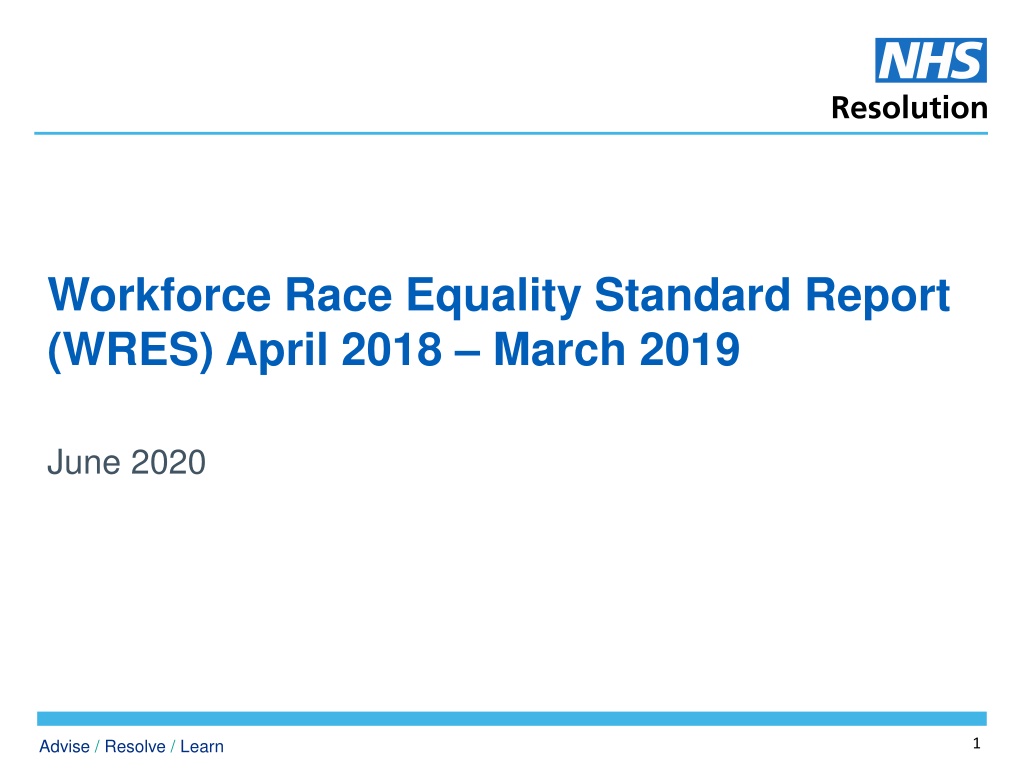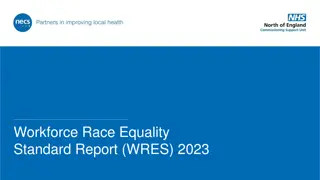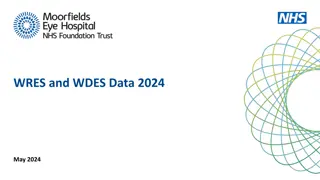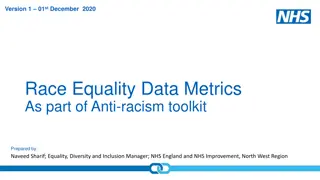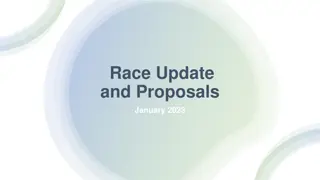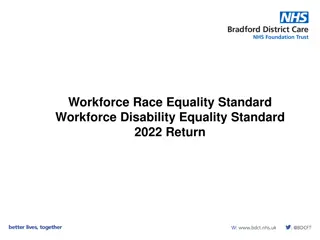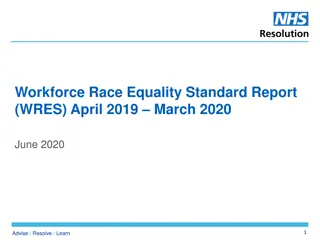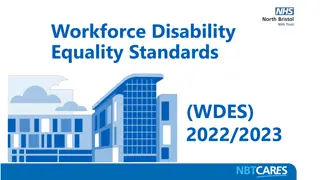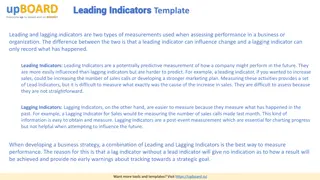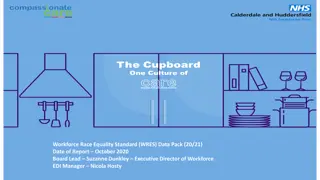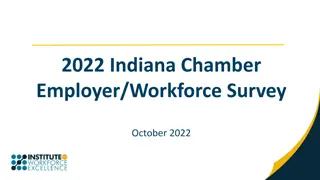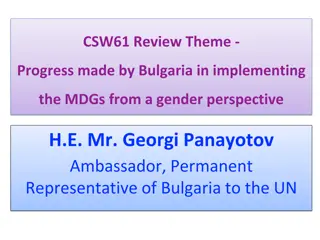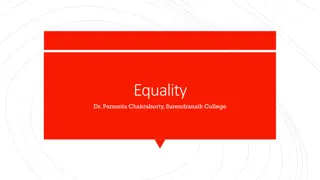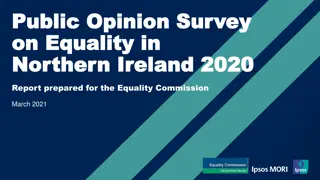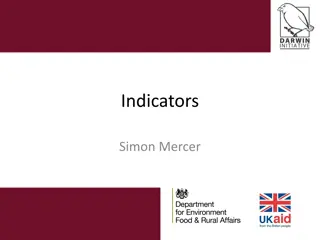Workforce Race Equality Standard Report (WRES) Findings and Indicators
The Workforce Race Equality Standard (WRES) report, mandated in 2015 for NHS commissioners and healthcare providers, aims to address workforce race inequality. This report presents findings from the 2018/2019 reporting period, including nine WRES indicators focusing on staff experiences and opportunities for Black, Asian, and Minority Ethnic (BAME) employees. The indicators cover aspects like workforce data, disciplinary processes, training access, and more. The report highlights the importance of identifying areas for improvement to enhance workplace diversity and inclusion.
Download Presentation

Please find below an Image/Link to download the presentation.
The content on the website is provided AS IS for your information and personal use only. It may not be sold, licensed, or shared on other websites without obtaining consent from the author. Download presentation by click this link. If you encounter any issues during the download, it is possible that the publisher has removed the file from their server.
E N D
Presentation Transcript
Workforce Race Equality Standard Report (WRES) April 2018 March 2019 June 2020 1 Advise / Resolve / Learn
Introduction The Workforce Race Equality Standard (WRES) was mandated in 2015 for NHS commissioners and NHS healthcare providers as a means of tackling workforce race inequality across the NHS. In 2017, national healthcare organisations were invited to implement WRES and report their findings against the nine WRES indicators. In line with our business plan and Equality Diversity and Inclusion (EDI) strategy, we committed to publish our WRES findings with the aim to identify and address any areas that will improve the workplace experience and representation at all levels for Black, Asian and Minority Ethnic (BAME) staff. Our 2018/2019 data is now complete and SMT have approved publication of the data on the NHS England website, where it will be compared against other submitting national bodies. This report presents our findings for the reporting period. 2 Advise / Resolve / Learn
The nine WRES Indicators To assist organisations to identify and improve BAME staff experiences and opportunities, they are required to collate and self-assess against nine indicators. The nine indicators were developed in collaboration with the wider NHS. Four focus on workforce data and four are based on data from the national NHS Staff Survey questions. The last indicator focuses upon BAME representation on boards. These are detailed in the table below: 1 2 3 4 5 6 7 8 9 Board National NHS Staff Survey indicators (or equivalent) Workforce indicators representation indicator Percentage of staff in each of the AfC Bands 1-9 and VSM (including executive Board members) compared with the percentage of staff in the overall workforce Relative likelihood of staff being appointed from shortlisting across all posts Relative likelihood of staff entering the formal disciplinary process, as measured by entry into a formal disciplinary investigation Relative likelihood of staff accessing non- mandatory training and CPD Percentage of staff experiencing harassment, bullying or abuse from patients, relatives or the public in last 12 months Percentage of staff experiencing harassment, bullying or abuse from staff in last 12 months Percentage believing that trust provides equal opportunities for career progression or promotion In the last Percentage of staff who have personally experienced discrimination at work from manager/team leader or other colleagues in the last 12 months This indicator presents the percentage difference between (i) the organisations Board voting membership and its overall workforce and (ii) the organisations Board executive membership and its overall workforce. 3 Advise / Resolve / Learn
The nine WRES indicators Each indicator compares data for white and BAME staff. For the purpose of reporting for WRES, White staff include White British, Irish, Eastern European and any other white . The Black, Asian and Minority Ethnic staff category includes all others except unknown and not stated. In the report, the data was analysed to show the likelihood or probability of an outcome for some indicators and this is presented in ratios. For example, for indicator 2, i.e. relative likelihood of staff being appointed from shortlisting across all posts, a figure of 1.15 would indicate that for every 1 BAME appointment, there are 1.15 White appointments. A figure below 1 would indicate that BAME staff are more likely than white candidates to be appointed from shortlisting. Given this was our first year of reporting, we were unable to make any comparative analysis. However, we are now in the process of submitting the WRES data for 2019/2020 and in the next report we will identify any year-on-year improvements or gaps and adjust our EDI action plan accordingly. The next set of slides presents the full breakdown of the NHS Resolution WRES results by indicator for 2018/2019. 4 Advise / Resolve / Learn
WRES Indicator 1 This indicator presents the percentage of staff in each of the Agenda for Change (AfC) Bands 1-9 or Medical and Dental subgroups and Very Senior Manager (VSM) (including executive Board members) compared with the percentage of staff in the overall workforce. The figures below represents permanent and Fixed term contract staff and does not include agency staff. BAME/White/Not Declared Number % of Workforce White 192 64.6% BAME 103 34.7% Not Declared 2 0.7% Total 297 100% The tables on the next page shows BAME and White representation in non-clinical roles by the total number of staff in each Agenda for Change (AfC) pay banding, VSM pay (employees who are paid above Band 9). In this reporting period, NHS Resolution did not employ staff in clinical roles (those who provide direct care to patients) or on medical and dental pay terms. 5 Advise / Resolve / Learn
WRES Indicator 1 Total Band White %White BAME %BAME % Headcount Difference Band 2 2 4 6 33.3% 66.7% -33.3% Band 3 1 4 5 20% 80% -60% Band 4 12 12 24 50% 50% 0% Band 5 12 7 19 63.2% 36.8% 26.3% Band 6 26 16 42 61.9% 38.1% 23.8% Band 7 48 30 78 61.5% 38.5% 23.1% Band 8a 26 10 36 72.2% 27.8% 44.4% Band 8b 28 12 40 70% 30% 40% Band 8c 18 2 20 90% 10% 80% Band 8d 11 4 15 73.3% 26.7% 46.7% Band 9 0 2 2 0% 100% -100% ESM/VSM 8 0 8 100% 0% 100% 6 Advise / Resolve / Learn
WRES Indicator 2 This indicator measures the relative likelihood of staff being appointed from shortlisted across all posts. Using the WRES Technical Guidance to calculate this indicator, the relative likelihood of White staff being appointed from shortlisting compared to BAME is 1.15 times. So, for every 1 BAME appointment, there are 1.15 White appointments. Timescale Number appointed from shortlist* Number shortlisted* (April 2018-March 2019) White 292 53 BAME 240 38 Not Stated 24 2 Total 556 93 *The figures include individuals shortlisted and appointed through roles advertised via NHS Jobs and through Expressions of Interests 7 Advise / Resolve / Learn
WRES Indicator 3 This indicator measures the relative likelihood of staff entering the formal disciplinary process, compared to that of White staff entering the formal disciplinary process, as measured by entry into a formal disciplinary investigation. NHS Resolution had no staff entering a formal disciplinary process within the reporting period. 8 Advise / Resolve / Learn
WRES Indicator 4 This indicator measures the relative likelihood of staff accessing non-mandatory training and CPD training. The relative likelihood of White staff accessing non-mandatory training and CPD as compared to BAME staff is 0.68. So BAME staff are more likely to access non-mandatory training and CPD than white staff. The data below shows number of non-mandatory CPD courses taken by White and BAME staff as well as staff who have opted not to state their ethnicity within the 2018/2019 reporting period. Timescale (April 2018-March 2019) No. of non-mandatory CPD courses taken* Headcount White 192 150 BAME 103 119 Not Stated 2 4 Total 297 273 *The number of non-mandatory CPD courses taken by staff includes where multiple opportunities have been accessed by a single employee. The figures only include the number of non-mandatory CPD courses accessed by individuals that were centrally recorded by the HR&OD Team. 9 Advise / Resolve / Learn
WRES Indicators 5 - 8 WRES indicators five to eight measure data from the national NHS Staff Survey questions. Although NHS Resolution did ask similar questions to the national NHS staff survey, we were unable to report on indicators five to eight for the 2018/2019 reporting period, as we did not collate responses to the 2019 interim staff survey by ethnicity. We were, however, able to provide the following narrative to support our response to each of the four indicators as presented on the following slide. 10 Advise / Resolve / Learn
WRES Indicators 5 - 8 WRES Indicators NHS Resolution Staff Survey Result % of staff experiencing harassment, bullying or abuse from patients, relatives or the public in last 12 months NHS Resolution is unable to report on this indicator, as the question was not asked in our most recent survey. Additionally, in 2019 we did not collate responses by ethnicity. We are taking steps to both collate responses by ethnicity and to replicate the national NHS staff survey questions for the purpose of WRES reporting going forward. % of staff experiencing harassment, bullying or abuse from staff in last 12 months The NHS Resolution survey results for this indicator show that 86% of respondents to the question reported that they had not experienced harassment, bullying or abuse from staff in the last 12 months. 14% reported that they had experienced harassment, bullying or abuse from a manager/team leader or other colleague. Of the harassment, bullying and abuse cases brought to the attention of the HR function within the reporting period, 100% were from a White background. % staff believing that trust provides equal opportunities for career progression or promotion For the NHS Resolution staff survey, respondents were required to report on their belief that the organisation provides equal opportunities for career progression or promotion specifically with regards to ethnicity. 65% either agreed or strongly agreed. 6% disagreed or strongly disagreed and 30% neither agreed or disagreed. % staff personally experienced discrimination at work from Manager/team leader or other colleague This question was asked in our survey but we are unable to provide breakdown by ethnicity. The NHS Resolution survey findings show that 92% of respondents to this question reported that they had not experienced discrimination from manager, team leader or other colleague in the last 12 months. 8% of those who responded, stated they had experienced discrimination at work from manager/ team leader or other colleague, although, there were no formal cases of discrimination raised with the HR function informally or formally within this reporting period. 11 Advise / Resolve / Learn
WRES Indicators 5 - 8 The results from the 2019 Interim Staff Survey, have been analysed and any areas of development have been addressed through the most recent Investors in People (IiP) survey and report, local action plans and the EDI strategy. For our 2020/2021 WRES submission, we are taking steps to both collate responses by ethnicity and to replicate the national NHS staff survey questions. We will revisit and adjust our EDI action plan to take into account the findings from that WRES report. 12 Advise / Resolve / Learn
WRES Indicator 9 This indicator presents the percentage difference between (i) the organisations Board voting membership and its overall workforce and (ii) the organisations Board executive membership and its overall workforce. White BAME Not Stated Number of staff in workforce 192 103 2 Total Board members by ethnicity 12 0 0 Total Board members - % by ethnicity 100% 0% 0% Voting Board members headcount 9 0 0 Voting Board members - % by ethnicity 100% 0% 0% Non-Voting members headcount 3 0 0 Non-Voting members - % by ethnicity 100% 0% 0% Executive Board members - headcount 4 0 0 Executive Board members % by ethnicity 100% 0% 0% Non Exec. Board members - headcount 7 0 0 Non Exec. Board members % by ethnicity 100% 0% 0% Overall Workforce - % by ethnicity 64.6% 34.7% 0.7% Overall Difference (total % Board total % workforce by ethnicity) 35.4% -34.7% -0.7% NHS Resolution currently has no BAME board members. It should be noted that Non- executive Director and Chair appointments are ministerial appointments managed centrally, therefore NHS Resolution has no control over the recruitment to these Board level positions. 13 Advise / Resolve / Learn
Action Plan At the time of reporting, we had not yet formulated actions as a result of the findings for the WRES 2018/2019. This is because the data was completed retrospectively in May 2020, and at the same time as completing our WRES 2019/2020. We have, however, outlined actions that need to be addressed following completion of the 2019/2020 WRES report, and you can view the actions in the 2019/2020 report. 14 Advise / Resolve / Learn
